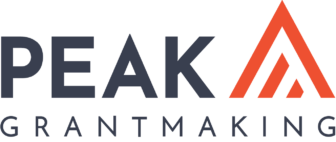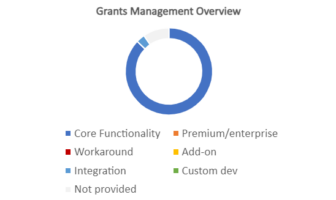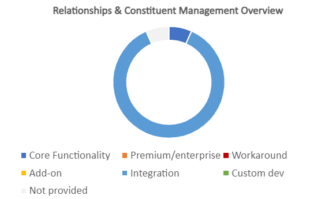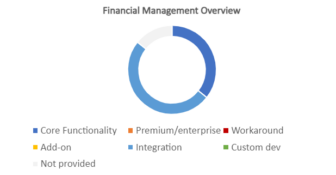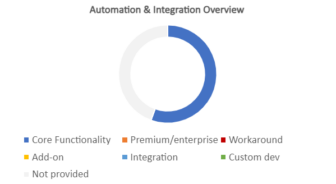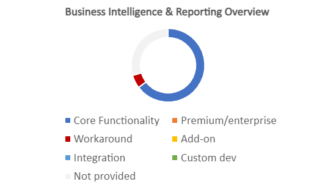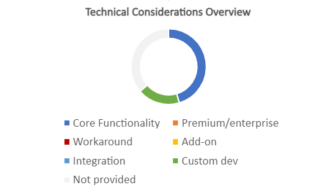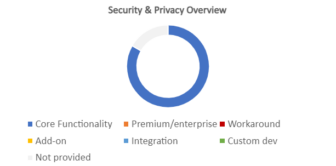Foundation Cloud, formerly known as GrantsEdge NXT and Spectrum NXT, is a full-featured grants and application management solution primarily used by community foundations and asset-managing organizations. It also supports religious foundations and arts councils. The system provides strong support for a variety of grantmaking programs, including organizational grants, individual grants, and scholarships.
Foundation Cloud is broken into two parts: Foundation Cloud Grants and Foundation Cloud Community Portal. Foundation Cloud Grants allows you to manage grants through their full lifecycle, including building applications, conducting due diligence, corresponding with applicants and grantees, and grant and impact reporting. Foundation Cloud Community Portal is the engine that drives the vendor’s external facing portals for applicants, grantees, reviewers, board members, donors, and vendors.
The platform does not include native CRM or financial accounting tools. Instead, it leverages pre-built integrations with Blackbaud, Salesforce, and Virtuous CRM platforms and with Blackbaud and Sage Intacct finance tools.
Vendor: NPact
Year Released: 2011
Pricing
Foundation Cloud’s pricing is calculated based on a customer foundation’s assets under management, gift, and grantmaking activities. The yearly subscription cost provides access to both Foundation Cloud Grants (the grant management tool) and Foundation Cloud Community Portal (the portal for external users, including applicants, grantees, reviewers, and board members). It also includes access to the PowerBI integration, the Twilio SendGrid integration, and the Candid integration. You can’t use Foundation Cloud by itself; it must integrate with a third-party CRM and financial accounting tool. The vendor has developed integrations with Blackbaud’s Raiser’s Edge NXT, Blackbaud CRM, Salesforce, and Virtuous CRM on the CRM side, and with Blackbaud’s Financial Edge NXT and Sage Intacct on the financial accounting side. The vendor reports that it will be releasing an integration with Oracle NetSuite later in 2024. The vendor typically locks in pricing for a minimum of three years. Implementation costs are priced separately, depending on the complexity of business requirements.
Estimated Yearly Costs:
- Small Foundation (< $25 million in grants, 1-5 staff): $20,000
- Mid-Size Foundation ($25-500 million in grants, 10-25 staff): $20,000-$50,000
- Large Foundation (> $500 million in grants, 50+ staff): $50,000+
Grants Management
The core of Foundation Cloud Grants is the grant record, which follows grants as they move through each workflow stage. Grant applications submitted via the Foundation Cloud Community Portal come into the database as submitted proposals or scholarships, which are then reviewed; processed, reopened, or declined; and turned into grants. Detailed constituent and organization information is viewable in the system, but most of that data is stored on a separate integrated CRM. The platform integrates with Candid and provides the basic GuideStar Charity Check functionality to all clients free of charge. The vendor reports that it is continuing to enhance the Candid integration and plans to roll out OFAC checks later in 2024.
The Foundation Cloud Community Portal is the external-facing site where the foundation can interact with applicants, grantees, reviewers, board members, and more. It can be branded with a foundation’s logo, colors, fonts, headers, and footers. First-time visitors to the portal are presented with a registration page that asks them to select which role they would like to register for: grant applicant, scholarship applicant, board member. It also includes the ability to search for your organization or to create a new one if your organization is not present in the database. The system does not auto-populate organization data via EIN. Site admins can then review and approve the new registrations in the grants system.
Once logged in, the landing page displays the constituent’s alerts, applications that the foundation wants to feature, applications that the constituent has recently accessed (with the current status of the application), grants that have been awarded to the constituent, and grant payments that have been made. It is possible for a site admin to create a report of upcoming payments using the system’s reporting functionality and push that out to the constituent’s portal.
Applications can be created for organizational grants, individual grants, or scholarships. You can build common scholarship applications that match applicants to a variety of scholarship funds. Application fields can include a multitude of data types, including conditional fields, calculated fields, reference requests, and file uploads. There is a size limit of 50MB for file uploads per field.
The system can prepopulate an application using the organizational information provided during portal registration, but does not have any integrations with centralized nonprofit data repositories. Two individuals from the same organization can work on an application, but the system does not facilitate collaboration between different organizations. Applicants can navigate through different pages of the application using the “Next” button or using the tabs at the top of the form. The system autosaves applicants’ work and lets applicants print their full application, not including attachments.
Contextual help is provided throughout the portal. Help text is available out of the box, but you can edit or customize the text as needed. You can change the help text on an application and add icons to fields that will bring up your custom information. You can also create a query in Foundation Cloud Grants to calculate the amount of time between the time and date an application is created and the time and date it is submitted to get data on how long it takes applicants to complete an application.
Grantees can submit required reports using the portal. The reports are set up as supplemental pages to the grant application and appear on the same application record, which is attached to a grant in the system. You can then create or link a new grant record for the next installment or add another payment to the existing grant record.
External reviewers access applications assigned to them through the portal. Reviewers can be placed on committees or in review groups for ease of assignment. The dashboard that displays when they log in shows them the committees that they’re on and the review groups of which they are a part. They can print the text of the application, but attachments need to be downloaded separately. Staff that access applications on Foundation Cloud Grants can download the application and the attachments. While reviewers can see the applications they are assigned, they are not able to access additional organization information held in the grants system. When you create an application, you can specify which questions you want reviewers to score and which application pages they are able to see. Scores can be numeric or text-based and reviewers can also add comments to their reviews. Numeric scores are totaled; you can see your own total score and lead reviewers can see scores from other reviewers as well.
Relationships and Constituent Management
In Foundation Cloud Grants, CRM functionality is achieved via integration. NPact has developed integrations with four popular CRM platforms: Blackbaud CRM, Blackbaud Raiser’s Edge NXT, Salesforce, and Virtuous CRM. Detailed organization and individual constituent information is stored on the external CRM but can be displayed in-system. While the integration is two-way, so that you can update data in Foundation Cloud Grants and have it show up in the CRM, the vendor recommends that you make all updates in the CRM as a best practice. Syncs with the external CRM are frequent, and you can also trigger a manual sync when needed.
All relationship management is done through the integrated CRM, and all interactions should be logged within the CRM rather than in the grants system. Correspondence sent from Foundation Cloud Grants is logged on grant records, but not on organization records in the system. You can build a variety of letter, document, and email templates in the system using a WYSIWYG editor, and these templates can pull in data from system fields. You can customize individual emails and letters and these customizations are saved to the grant record. Emails are sent via an integration with Twilio’s SendGrid platform.
Board portal functionality is included as part of the Foundation Cloud Community Portal. Board members can log in to the portal and review, approve, or deny grants on an individual or docket level. You can also upload documents to the portal for board members, which helps you distribute agendas or meeting minutes. The vendor has a separate product, DonorCentral, to manage Donor Advised Fund programs.
Financial Management
As with the CRM functionality, much of the financial management functionality is accomplished via integration with one of two systems: Blackbaud Financial Edge NXT and Sage Intacct. The vendor reports that it is working on an integration with Oracle NetSuite, which it anticipates being available later in 2024.
Foundation Cloud Grants does has some limited payment scheduling and tracking functionality. You can set up a default payment schedule for grants and customize the payment as necessary, and you can set up contingent payments as well. Payments can be split between funds but can only be associated with one budget. You then batch payments in a check run, which is sent over to finance. Check runs can be set up to run as an overnight sync, and then you are notified of any errors. Once the batch is run, the payment status is automatically updated on associated records. There’s no limit on how many payments you can send over to finance.
You can set up budgets in the system and track drawdowns. While there is no formal forecasting functionality in the system, the vendor reports that you can create “what if” scenarios with a custom report. The vendor does have a fund investment tool available as a separate product.
Automation and Integration
You can build a variety of custom workflow templates in the system to meet the needs of different grant processes. Notifications for tasks and application confirmations are sent via automated emails. Numerous batch processes can be run in the system, including batch check runs, batch correspondence, batch dockets, and batch proposals.
The vendor reports that it does not have any private APIs but has released a beta public API and plans to release further enhancements in the near future. As noted previously, it has pre-built integrations with four popular CRM platforms and two finance/accounting platforms, with a third accounting integration in development. It also has a basic Candid GuideStar Charity Check integration, a Twilio SendGrid integration, a Fiserv integration, and an integration with Microsoft PowerBI that is the basis for reporting and dashboard functionality.
Business Intelligence and Reporting
Dashboards in the system are created via an in-system integration with Microsoft PowerBI and are accessed via the Reporting section of the menu. The system comes with one out-of-the-box PowerBI dashboard and one impact tab with geographic heat map, as well as the ability to create your own personalized PowerBI dashboards. Each section of Foundation Cloud Grants has a couple of overview charts at the top of the page, with a table of records underneath that you can sort and filter. A global search is available but it does not search the content of attachments.
The system includes a variety of out-of-the-box queries that allow you to sort and filter the data and that you can export as .CSV files. It also offers more than 50 paginated reports out-of-the-box. You can make changes to any of these pre-built reports and save them as new reports, but you are not able to mark any as favorites or schedule them to be run at a future time. You can create your own custom queries based on any fields in the system. Progress toward outcome goals can be calculated with custom reports, provided you are collecting that data in the system.
You can create a large variety of data visualizations within the system via the PowerBI integration. These visualizations allow you to click through to underlying data if you created the report. You can export these PowerBI charts and visualizations in a variety of formats.
Technical Considerations
The system is designed responsively to display across a variety of devices. The vendor reports that it is in partial compliance with WCAG accessibility guidelines. There is no default taxonomy available out-of-the-box, but the vendor says it usually pulls in the taxonomy used in the integrated CRM platform to ensure that data is consistent across systems. However, it can also set up a custom taxonomy if the client wishes. It is also possible to import grants into the system via .CSV.
The donor portal is available in English and French, and the language can be changed by administrators in the settings tab of the portal. More extensive multilingual capabilities and online translation integration require custom development. You can select either U.S. or Canadian dollars as your standard currency for grants, but multi-currency grant functionality is not available.
Security and Privacy
Role-based security determines what individuals can see or do in the system. The software comes with a limited number of preset roles, but you can customize those roles and add new ones as needed. The PowerBI dashboards are displayed through a separate set of permissions. Multi-factor authentication is available to enforce login security, but there is no single sign-on capability. Data is encrypted both in transit and at rest. The system logs whenever someone takes an action or makes a transaction for audit purposes. The vendor’s privacy policy is available on their website and they provide their security, SLA, and disaster recovery policies to potential and existing customers upon request.
Training and Support
|
|
Included | Additional Cost |
Not available |
|
Phone |
X |
||
|
Chat |
X |
||
|
|
X |
|
|
|
Knowledgebase |
X |
|
|
|
Training Videos |
X |
|
|
|
User Community |
X |
|
|
|
Implementation |
X |
Clients have access to a knowledgebase, email support, and a user community. The vendor does not provide support to applicants, reviewers, or board members who use the portal, but the foundation does have the ability to create and update custom help text throughout the portal. Integration is priced separately from the yearly subscription cost, based on the complexity of the client’s needs. New users can access training videos and the vendor provides frequent training webinars for all users.
Customer Experience Survey
Number Of Survey Respondents Using The System: 0

